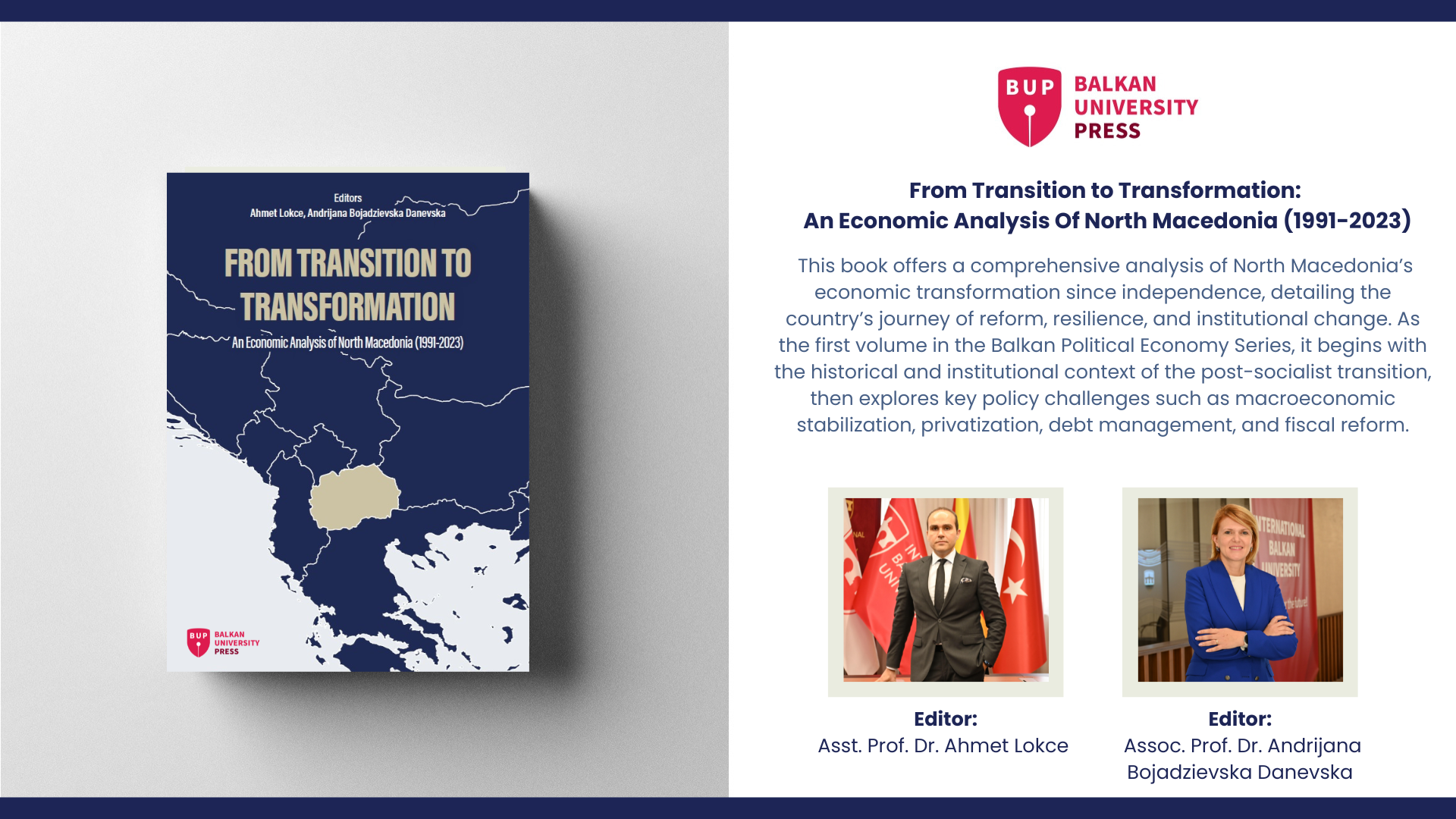BUP Interview with Prof. Marija Miloshevska Janakieska
Balkan University Press (BUP) is launching the Architecture and Design Book Series edited by Prof. Miloshevska Janakieska who co-authored the book “Wood Reimagined: Sustainable Architecture with Engineered Wood Products” that is going to be published by BUP this summer. In this interview, she helps us discover how wood as a material used in architecture is both esthetic and practical, but most importantly: sustainable.
BUP: Prof. Miloshevska Janakieska, please tell us what inspired you to write a book on sustainable architecture, specifically focusing on engineered wood products?
MMJ: Sustainable architecture has always been a significant part of my expertise and passion. My journey began a long time ago, during my bachelor studies in architecture when I won an award for a sustainable design of a building – Students’ Dormitory. With this project my love for sustainable architecture was born. During my PhD studies, I furthered my knowledge by attending a training school in England focused on sustainability, extensively researching the literature on this topic, and analyzing and testing various aspects of sustainability in buildings, including research of numerous projects and case studies where sustainability is involved.
On the other hand, wood, as a material, has always fascinated me with its aesthetic appeal and versatility in architecture. As a natural material, it is a perfect choice for sustainable architecture, and it has a rich tradition as an architectural material since ancient times. Unfortunately, in recent decades, wood has been neglected in Macedonian construction practices due to a lack of information, experience, and production capacities.
With this book, we aim to inspire architectural students, architects, engineers, investors, construction companies, industry representatives, and everyone involved in construction processes to embrace wood as an important material. Engineered wood products offer a wide range of possibilities for both structural and non-structural applications, including exterior and interior design, furniture design, and landscape architecture. By showcasing these products, their characteristics and their applications, we hope this book will enhance knowledge about wood and its potential, encouraging its increased use in our country.
BUP: This book was a collaboration project between you and two esteemed professors: Prof. Dr. Manja Kitek Kuzman from University of Ljubljana, Slovenia and Prof. Dr. Dick Sandberg from Lulea University of Technology, Sweden. Please explain how do these three countries compare in respect to sustainability in architecture and using wood as a material?
MMJ: Both professors are highly esteemed and acknowledged in their countries for their expertise in sustainability, wood, and wood-based products. Professor Manja Kitek Kuzman’s research and teaching interests revolve around developing wood construction, innovative use of wood, sustainable wood products, and product design. Professor Dick Sandberg’s research covers material properties, wood-scanning technology, wood machining, and wood production systems.
Slovenia and Sweden are developed countries with a strong awareness of sustainability and high wood application in construction. Concepts such as sustainability, circular economy, restorative environmental design, and biophilic design are frequently discussed and integrated across various sectors in these countries. Their focus on using natural materials and prioritizing the well-being of users is evident. For example, the fact that 99% of houses in Sweden have timber structures speaks about their commitment to using wood.
I believe it is crucial for us to follow their innovative ideas, practices, and expertise and apply them in our own country. In Macedonia, the wood sector has a rich tradition and has always been a significant part of our economy. Nearly 40% of our country is forested, with a variety of naturally occurring tree species. This indicates an important potential for developing a successful wood sector and increasing wood application, particularly in the construction.
This collaboration allows us to share the extensive experience of Slovenia and Sweden and raise awareness about sustainability in Macedonia. By incorporating their advanced practices and knowledge, we can enhance our projects and promote the use of wood and engineered wood products, that will not only contribute to sustainable development but also use our country’s natural resources.
BUP: Your book is the inaugural volume of the BUP "Architecture and Design Series," which you also edit. Are there any other forthcoming publications within this series, what is the series scope, and are there any open calls for book proposals?
MMJ: Yes, my book, Wood Reimagined: Sustainable Architecture with Engineered Wood Products, is the inaugural volume of the Balkan University Press "Architecture and Design Series," which I also edit. The scope of the series is broad, encompassing various aspects of architecture and design. Our aim is to publish books that will explore innovative design practices, sustainable architecture, building design, interior design, urban planning, landscape design, historical and cultural heritage, novelty materials and technology.
We are already working on several forthcoming publications. Our colleague, Asst. Arbresha Ibrahimi, who just finished her PhD studies in Ljubljana Slovenia is preparing her book which will emerge from her doctoral dissertation. The book elaborates the perception of cultural identity in promoting the architectural and urban identity of museums. It critically analyzes Skopje's identity and its impact on the development of existing museums, as well as the reuse of museum capacities for regenerating not only architectural but also urban identity.
Moreover, we have an open call for book proposals. We encourage scholars and professionals with original research and innovative ideas to submit their proposals. By bringing together diverse perspectives in these series, we aim to enrich the field of architecture and design.
BUP: As a university professor at International Balkan University, how do you integrate the principles of sustainable architecture and the use of engineered wood products into your teaching curriculum?
MMJ: As a university professor at International Balkan University, my teaching is deeply connected to my expertise, which gives me a great pleasure. I teach courses such as Sustainable Architecture, Architectural Structures and Architectural Design, where I can share my knowledge on sustainability, energy efficiency, living comfort, biophilic design, circular economy, restorative environmental design, and construction practices in wood from the past, as well as modern structural systems with wood and wood-based products. My goal is to transfer theoretical knowledge to my students while integrating practical examples, like those from Slovenia and Sweden, to provide a real-world context.
I believe that besides theoretical knowledge, practical knowledge is crucial for becoming an architect. Therefore, I ensure that my students engage in projects where they can apply what they learn in class. I inspire them to embrace sustainability in their designs and to use wood and wood-based products as extensively as possible. It is nice to see how engaged and enthusiastic my students are about using wood in their projects. They frequently seek consultations, asking for more information, examples, and details to incorporate timber into their work. As a result, we have more and more students’ projects where sustainable aspects are taken into consideration and wood is used as a structural and non-structural material. Some of these projects were submitted to international competitions worldwide. This fills me with hope for the future. I am confident that these passionate students will become the next generation of architects who prioritize sustainable practices and innovative use of materials, contributing to a more sustainable and environmentally conscious built environment.
BUP: You are also the Editor in Chief of the Journal of Balkan Architecture that is going to be launched in December 2024. Please share more information about the journal.
MMJ: Yes, I am very proud to be the Editor in Chief of the new Journal of Balkan Architecture (JBA), part of the esteemed Balkan Journals collection. The primary aim of JBA is to bridge the gap between the academia and the industry, by initiating collaboration and knowledge exchange in the field of architecture. The journal will offer a visually engaging and interesting reading experience for architects, researchers, and design professionals. It will integrate scientific research papers, artistic contributions, and project presentations, providing a comprehensive platform for exploring innovative approaches and cutting-edge topics in Balkan architecture. With this mixed approach, the journal will promote dialogue, inspire creativity, and advance architectural knowledge and practice.
We welcome scientific contributions across diverse architectural disciplines, including architectural design, interior architecture, cultural heritage, historical preservation, urban planning, sustainable architecture, digital technologies, and interdisciplinary approaches. Our aim is to advance understanding and application in these key domains.
For artistic papers, we encourage creative contributions in various forms within architecture, such as installations, digital architecture, media arts, sculptural forms, photography, architectural drawings, and the intersections of architecture with poetry, philosophy, psychology, and sociology.
The deadline for the submission of papers for the first issue is October 1st, 2024. I warmly invite all interested contributors to submit their work and contribute to this innovative platform.
Asst. Prof. Marija Miloshevska Janakieska is a professor at International Balkan University. Her research interests are architecture, architectural Structures, building materials, sustainability.



















































.png)



.png)

.png)

